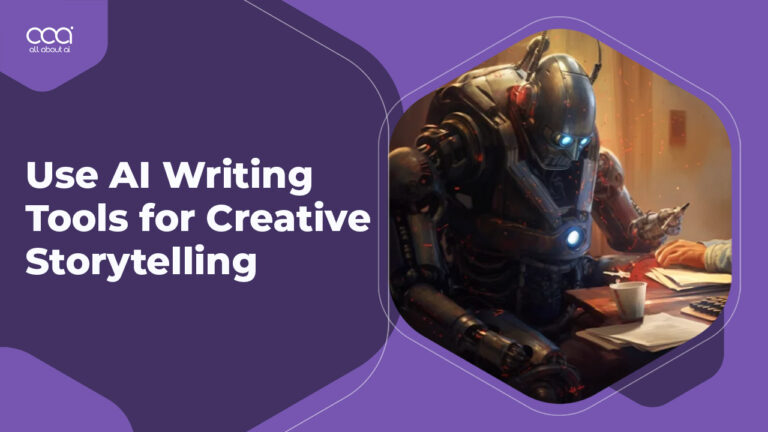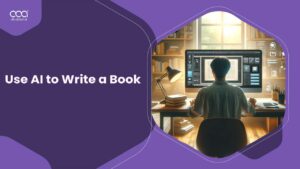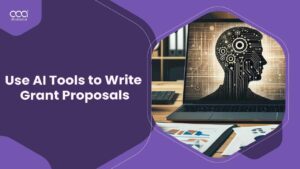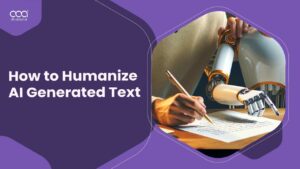In the rapidly evolving landscape of technology, AI tools have emerged as a versatile ally in the realm of content creation, particularly in storytelling. With their ability to process and generate text based on vast data, AI tools are increasingly being sought after for crafting narratives.
This article will talk about how to use AI writing tools for creative storytelling, discussing steps, why writers should use the best AI writing tools to write engaging and compelling stories, and so on.
How to Use AI Writing Tools for Creative Storytelling
Before diving into using AI for storytelling, it’s important to understand what AI writing tools are capable of and their role in creative writing. These tools, powered by advanced algorithms and machine learning, can generate text based on input data.
They can mimic different writing styles, suggest plot developments, create dialogue, and even help with character development. However, they work best when guided by human creativity and insight.
Step 1: Choosing the Right AI Writing Tool
Selecting the appropriate AI tool is crucial for your storytelling endeavor. Factors to consider include:
- Language Proficiency: The tool’s ability to understand and generate coherent and nuanced text.
- Flexibility: How well the tool adapts to different genres and writing styles.
- User Interface: The ease of use and accessibility of the tool.
- Customization Options: The extent to which you can tailor the tool’s output to your specific needs.
Step 2: Determining the Genre, Theme, and Style
Deciding on the genre, theme, and style of your story is a vital step. The genre (sci-fi, fantasy, romance, etc.) sets the overall framework, the theme provides depth and message, and the style (such as descriptive, concise, dialog-heavy) defines the storytelling approach. AI tools can be steered towards these elements to generate relevant content.
Step 3: Creating a Story Prompt
Crafting a clear and engaging story prompt is essential. This prompt should include key elements of your story, such as the main characters, setting, and a hint of the plot. A well-defined prompt helps the AI understand the direction in which to develop the story.
Step 4: Setting Limits and Constraints for AI
AI can sometimes produce unexpected or irrelevant content. Setting limits, like specifying a word count, defining character traits, or limiting the scope of the story, helps in keeping the AI’s output aligned with your vision.

Step 5: Inputting the Story Prompt into the AI Tool
Once your prompt is ready, input it into the AI tool. This is where the magic begins, with the AI using your prompt as a starting point for generating the story.
Step 6: Adjusting Parameters for Creativity and Control
Most AI tools allow you to adjust parameters that affect creativity and control. Tweaking these settings can help you find the right balance between the AI’s creative autonomy and your control over the narrative.
Step 7: Generating and Reviewing the AI-Generated Story
After inputting your prompt and adjusting the settings, generate the story. Review the output carefully. It’s common to go through several iterations, refining the prompt or adjusting settings, to get the desired outcome.
Step 8: Editing and Redefining the AI-Generated Story
The AI-generated story is rarely the final product. Editing and redefining the story is important to give it a unique touch. This involves revising for coherence, emotional impact, and ensuring that the story aligns with your original vision.
What is AI Story Generation?
AI story generation involves using artificial intelligence to create narratives, demonstrating how to use AI writing tools for creative storytelling effectively. By analyzing patterns in language and storytelling from extensive databases, these tools generate coherent and engaging stories.
Key elements in AI story generation include plot development, character creation, and dialogue generation. Tools like GPT-4 have demonstrated remarkable proficiency in this domain, offering writers a new avenue to explore storytelling.
Why Should a Writer Use an AI Story Generator?
AI story generators are game-changing tools for writers, helping them overcome writer’s block and create amazing stories.
This section will explore how these generators can act as creative partners, offering unique ideas and aiding in story development.
Unleashing Creativity
AI story generators introduce a new dimension of creativity, providing fresh perspectives and ideas that a writer might not have considered. This feature is especially beneficial for overcoming writer’s block or when seeking novel inspiration.

Speeding Up the Writing Process
These tools aid in rapidly developing story outlines, character profiles, and dialogues, thereby accelerating the writing process. This aspect is particularly useful for writers facing tight deadlines or looking to increase their overall output.
Learning and Experimentation
For novice writers or those looking to expand their skills, AI can serve as a learning tool, offering insights into narrative structure and storytelling techniques. It also allows writers to experiment with different styles and genres with relative ease.
Key Benefits of Using AI Writing Tool for Creative Writing
Exploring how to use AI writing tools for creative storytelling can transform the craft, offering writers the ability to enhance efficiency, diversify storytelling techniques, and venture into uncharted narrative territories, making these tools a valuable asset in today’s creative writing landscape.
Enhanced Productivity
AI tools facilitate the quick generation of content, enabling writers to produce more work in less time, thereby significantly boosting productivity.
Diverse Writing Styles and Inspiration
With the ability to mimic various writing styles, AI provides writers with a range of linguistic and narrative options. It can also spark new ideas, aiding writers in exploring uncharted storytelling territories.
Language and Grammar Refinement
These tools can assist in refining language use, suggesting better word choices, and improving grammatical structure, which is crucial for crafting polished and professional narratives.
Accessibility in Storytelling
AI writing tools make storytelling more accessible, especially for amateur writers or individuals with limitations that make traditional writing challenging.
Real World Examples of Successful AI Generated Stories
AI-generated storytelling has already shown promising results in various fields, marking significant achievements and paving the way for future innovations.
Literature
One notable success in literature is the novel “The Policeman’s Beard is Half Constructed,” co-written by an AI language model, GPT-2, and human author Ross Goodwin.
This novel stands out as the AI generated most of the text, while Goodwin provided the plot and structure. It was long-listed for the National Book Award in 2019, showcasing the potential of AI in creating high-quality literary works.
Gaming
In the gaming industry, AI Dungeon is a remarkable example where players input prompts, and the AI generates a text-based adventure story in response. The game is known for its surprising and unpredictable stories, with the AI creating imaginative scenarios and characters tailored to the player’s interests.

Advertising
The advertising sector has also seen innovative uses of AI storytelling. Lexus’s “Driven By Intuition” campaign is a prime example, where AI was used to create a commercial featuring a car that appeared to be driving itself.
The story was developed using various data sources, including social media and weather data, and received widespread acclaim for its innovative use of AI.
Journalism
In journalism, the Associated Press has utilized AI to cover topics such as corporate earnings reports and sports games. These stories, generated using data feeds and templates, often match the quality of those written by human reporters.
This application of AI allows for the quick and efficient production of news stories, freeing up human reporters for more in-depth and investigative work.
AI In The Future of Storytelling and Content Creation
As we peer into the future of storytelling and content creation, the pivotal role of AI is undeniable, particularly in exploring how to use AI writing tools for creative storytelling. This section will navigate the expected advancements in AI, highlighting their potential to revolutionize storytelling through personalized narratives and enhanced immersive experiences.
Emotional Resonance and Sophistication
Future advancements in AI are expected to lead to a deeper understanding and replication of human emotions in storytelling, resulting in more emotionally resonant narratives.
Collaboration and New Genres
The collaboration between AI and human creativity might give rise to new genres and methods of storytelling, expanding the horizons of traditional narrative forms.
Personalized Story Experiences
In interactive media such as gaming, AI could offer personalized story experiences, adapting to the preferences and decisions of individual players.
Democratization of Storytelling
AI’s role in making storytelling more democratic is significant, as it enables people from various backgrounds to share their stories, thus contributing to a richer and more diverse narrative landscape.
FAQs
In this section, we’ll address common questions about the use of AI in writing, its capabilities, and the ethical considerations it entails, providing clarity on how AI is transforming the art of storytelling.
How is AI used in storytelling?
Can AI write creative stories?
Can AI narrate a story?
What is the best AI storytelling tool?
Conclusion
The best AI tools are revolutionizing the art of storytelling. By blending AI’s computational prowess with human creativity, these tools are not just assisting writers but also redefining the boundaries of narrative creation. As AI continues to evolve, its role in storytelling is set to become more integral, opening new horizons for creators worldwide.
Now that you know how to use AI writing tools for creative storytelling, what story are you going to write first? If this article has piqued your interest and you want to learn how to create content using various AI tools, check out the other articles we have in our How To section.





